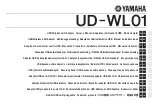
byte-synchronous modes. This would seem to preclude the use of the MPAP-200's external
FIFOs with byte-oriented protocols.
To make the external FIFOs more useful in byte-synchronous modes, the MPAP-200 can
watch for a given character to be transferred consecutively a specific number of times from the
SCC into the receive FIFO. When this occurs, the RX_PAT bit in the Interrupt Status Register
(see page 38) is set. For instance, the MPAP-200 can watch for the end-of-text character to be
received, or for three consecutive pad characters to be received.
For byte-synchronous operation with simple unique markers in the data stream, this
feature may be quite useful. Even if it is not, however, the MPAP-200 can certainly be operated
with per-character interrupts enabled and the external FIFOs disabled. The tradeoff will be a
heavier interrupt burden and possibly somewhat lower throughput.
NOTE
While most useful in byte-synchronous modes, the
receive pattern detection feature can be used in any
operational mode.
42
















































